Franco-Prussian mixed postage 1870-1872
The Franco-Prussian War (1870-1871) led to significant disruptions in postal services across France and the newly formed German Empire. As German forces occupied various French departments, unique postal arrangements emerged, resulting in the phenomenon known as Franco-Prussian mixed postage. This system involved the use of both French and German occupation stamps on correspondence between occupied and free zones.
On 28 January 1871, an armistice was signed between Otto von Bismarck, representing the German states, and Jules Favre, representing the French government, effectively ending the Siege of Paris and marking the near conclusion of the Franco-Prussian War (1870–1871). By the time of the armistice, German forces occupied all or part of 30 French departments.
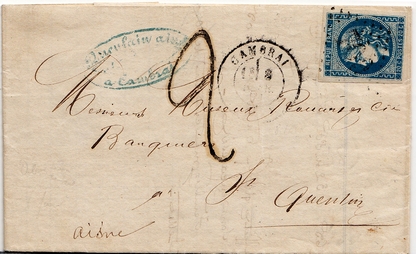

Letter mailed on 8 February 1871 in CAMBRAI (free zone) for ST QUENTIN (occupied zone). The postmen in ST QUENTIN have applied a 2 décimes tax.
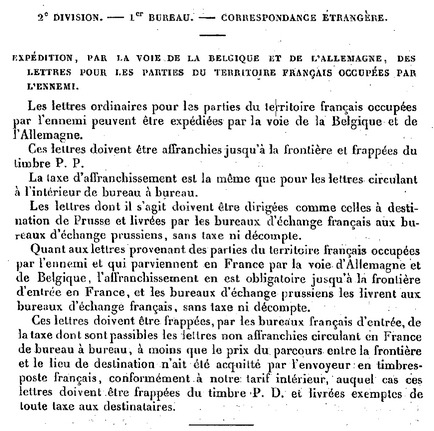

Extract from Monthly Bulletin no. 27 of September 1870.
The Armistice was signed on 28 January 1871. Article 15 of the agreement stipulated:
"A postal service for unsealed letters will be organised between Paris and the departments via the Versailles headquarters."
Following this provision, an agreement was reached between Germain Rampont (Director General of the French Post Office) and Joseph Rosshirt (Postal Administrator in the occupied territories). The first article of this agreement specified:
"Ordinary letters from Paris to French territories occupied by German troops, and vice versa, will be subject to a tax of 40 centimes. Each of the contracting parties will collect 20 centimes, ensuring that no accounting will be required for the exchange of these letters. For letters weighing more than 10 grams, the tax will be calculated according to the French postage scale for franked letters. Such letters will be delivered to the German office in Versailles, sorted by department."
To cover postage costs, the public had two options:
Use French stamps to prepay the French portion of the postage.
If available, fully prepay the postage with occupation stamps, covering the German portion as well.
Alongside this agreement, the tax on letters exchanged between the occupied and free zones (excluding Paris) remained fixed at 30 centimes, payable by the recipient, as per the service order of 28 January 1871.
On 27 February 1871, the Moniteur Universel published a public notice dated 25 February, announcing the restoration of postal services between the occupied and unoccupied departments. The taxation system for these letters mirrored that of correspondence between Paris and the occupied departments, introduced nearly a month earlier:
"Letters from occupied departments to non-occupied departments, and vice versa, will be subject to a charge of 20 centimes per single letter, which must always be paid by the addressee."
On 10 March 1871, a postal agreement between Rampont and von Stephan (effective from 24 March 1871) enabled the French postal administration to resume postal services in the occupied departments. This agreement marked the end of the mixed postage system in these areas. However, postal relations with Alsace and Lorraine, which had been ceded to Germany, remained subject to different regulations.
On 23 March 1871, Albert Miessner, Director General of the Strasbourg Post Office, issued Notice No. 167, imposing a 30-centime tax on all incoming correspondence from France, payable by the addressee. This measure formally integrated Alsace-Lorraine into the German postal system, separating it from the rest of France.
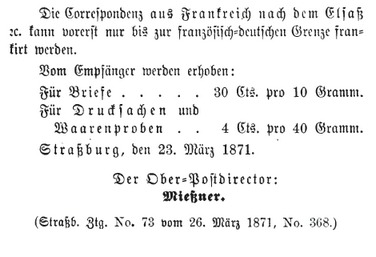

Extract from notice no. 167 published in the Verordnungen und Amtliche Nachrichten für Elsass-Lothringen.
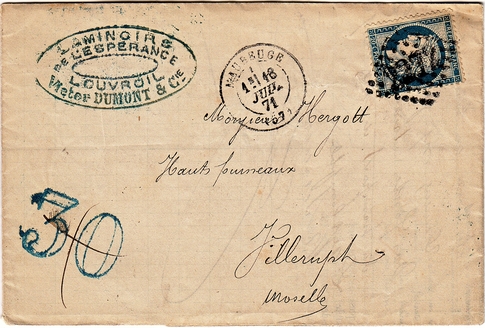

On 24 July, Director Miessner published a new notice announcing that from 1 August, the tax charged to addressees of letters from France would be set at 20 centimes.
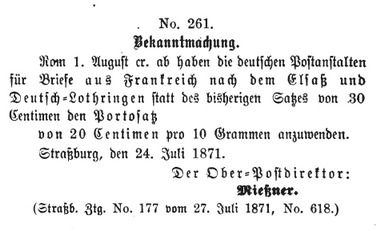

Extract from notice no. 261 published in the Verordnungen und Amtliche Nachrichten für Elsass-Lothringen.
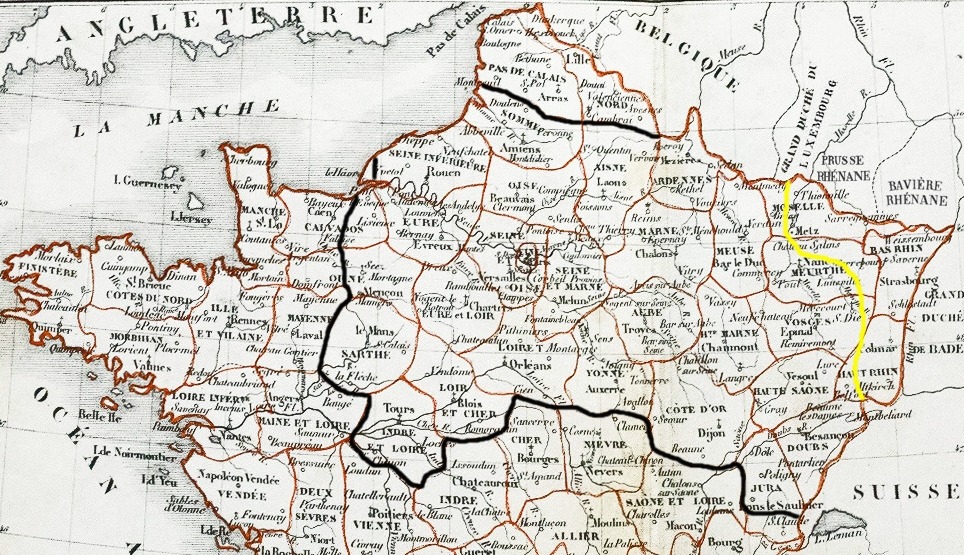

Since October 1870, the postal administration of the North German Confederation (Norddeutsche Postverwaltung) had managed postal activities in the occupied territories through three entities:
The General Postal Directorate for Alsace (Oberpostdirektion für Elsass), based in STRASBOURG since 4 October;
The General Postal Directorate for Lorraine (Oberpostdirektion für deutsch Lothringen), initially established in NANCY on 6 October, before relocating to METZ on 31 October 1870;
The Postal Administration for Occupied Territories (Administration der Posten in den besetzten französischen Gebieten), first set up in Nancy on 24 August 1870, then moved to REIMS on 6 October 1870.
The establishment of these three administrative bodies was driven by Germany’s long-term objective of annexing Alsace and Lorraine, necessitating the creation of a lasting postal infrastructure. Circular no. 73, published on 13 October 1870 in the official journal of the North German Confederation Post Office, referenced an order issued by Wilhelm I on 12 September:
"In response to your report of the 12th of this month, I authorise that the postal system in the area of the General Government of German Alsace and Lorraine be immediately and definitively organised by the Postal Administration of the Confederation of Northern Germany, and that for this purpose two general postal directorates be created, as well as the provisional postal administration in the other occupied French territories on the basis of existing institutions."
Additionally, on 6 September (Circular no. 64), the North German Confederation Post Office announced the issuance of occupation stamps denominated in centimes (mistakenly referred to as Alsace-Lorraine stamps by collectors). These stamps had, in fact, already been printed since early August.
On 24 March 1871, postal services were returned to French administration in all departments except Bas-Rhin, Haut-Rhin, and Moselle, as well as parts of Vosges and Meurthe, which were annexed by Germany. This annexation was later ratified by the Treaty of Frankfurt, signed on 10 May 1871.
Throughout the war, postal relations between the belligerents continued—something that may seem surprising in today’s world. Although direct postal exchanges ceased, communication remained possible via neutral countries such as Switzerland, Belgium, and Great Britain.
However, it must be noted that from the outbreak of war to the signing of the armistice, the volume of mail between the free and occupied zones remained extremely low. Commercial correspondence had largely ceased due to the collapse of trade between the two zones, leaving only personal letters to be exchanged.
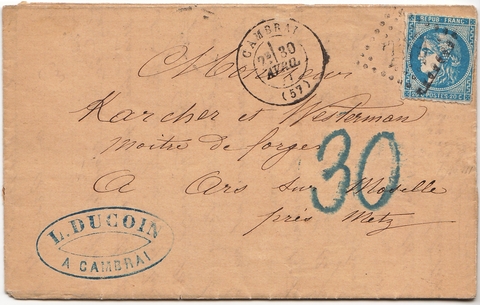

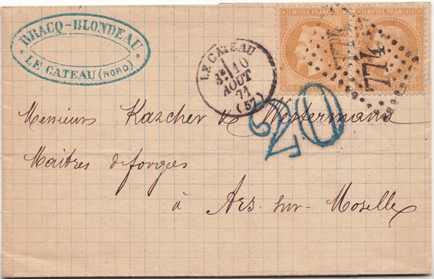

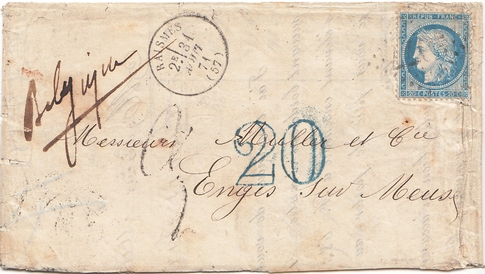

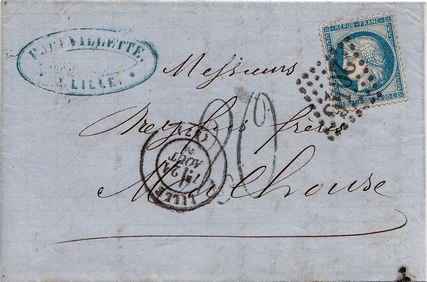


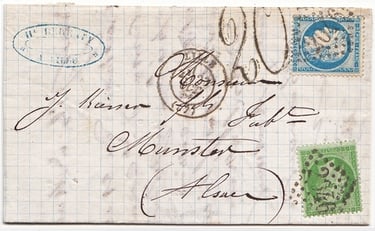
Letter franked at 25 c (tariff of 01/09/1871) for MUNSTER. Tax "20" applied at MULHOUSE.
Letter franked at 25 c (tariff of 01/09/1871) for COLMAR. Tax "2" Groschen applied in MULHOUSE.
Letter from LAPOUTROIE (SCHNIERLACH) for LILLE franked at 2 groschen in with german stamps. Tax "25" centimes applied by the railway post office AVRICOURT-PARIS.
Numerous French and German tax stamps can be found throughout the period of the mixed postage.
Since the declaration of war, France and Germany had maintained postal relations without a postal convention. On 12 February 1872, an agreement was finally signed that came into force on 25 May. The mixed port system came to an end.
Letter franked at 40 c in accordance with the Franco-German convention of 1872 for SCHILTIGHEIM.
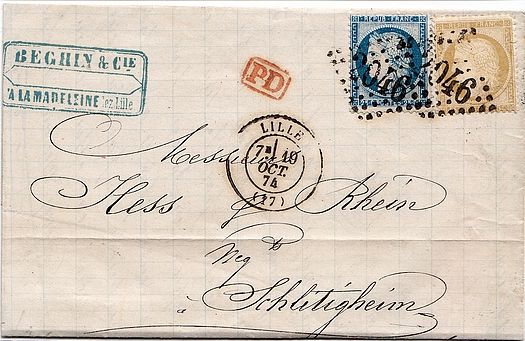

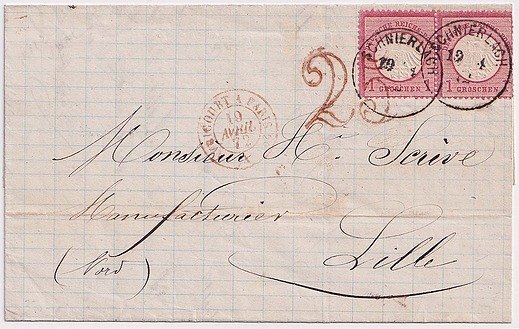


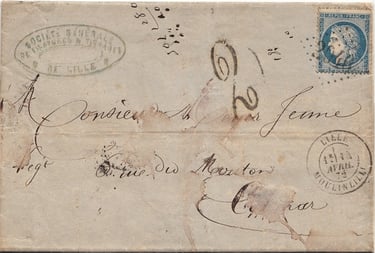
Map of occupied French territories on 28 January 1871.
Black line: limit of the advance of the German armies
Yellow line: annexed territories.
Why Mixed Postage?
With the suspension of postal agreements between the belligerent states, the pre-existing system of annual postal compensation was no longer in effect. As a result, each postal administration—French and German—claimed its share of the postage directly from either the sender or recipient.
Establishing and Implementing Mixed Postage
The creation of a postal administration for the occupied territories in NANCY, under the direction of Joseph Rosshirt, aimed to restore a postal service that had ceased to function. This service needed to be profitable and was expected to rely on the cooperation of French civil servants who remained in their posts, as well as the possibility of maintaining postal exchanges between the free and occupied zones.
However, from the outset, French civil servants refused to cooperate with the German authorities.
On 27 August 1870, Heinrich von Stephan, Director General of the Post Office of the North German Confederation, proposed a compromise to his French counterpart in Paris, Édouard Vandal:
"Dear Mr Director General,
Post offices located in French territory occupied by German armies often receive correspondence bound for France.
I have the honour of informing you that the No. 10 Cologne-Verviers railway post office will deliver this correspondence to the French exchange offices without tax (compulsory franking having been decreed for these items).
I would like to propose to you, Mr Director General, that correspondence originating in France and bound for French territories occupied by German armies be treated in the same way […]".
Although this proposal would have benefited users and facilitated the handling of correspondence, it also implied that the French administration recognised the legitimacy of a foreign postal system operating on its own territory—even if that territory was occupied.
Furthermore, as we shall see later, the proposal was based on the principle that occupation stamps would be valid for the entire domestic postage to the recipient. However, this point was not clearly articulated. In von Stephan’s view, the 20-centime postage using occupation stamps was intended to cover the entire inland postage within France, including both the occupied and free zones, up to the recipient.
The French administration, however, had already been aware of German intentions before von Stephan’s letter of 27 August. Unwilling to accept such an arrangement, it issued a service order on 8 September, published in Monthly Bulletin No. 27 (September 1870). This directive stipulated that letters from the occupied territories were to be considered unfranked and taxed at 30 centimes unless they bore French stamps.
This firm stance by the French authorities effectively rejected the German proposal, reinforcing the divide between the occupied and free zones and preventing the seamless postal exchanges envisioned by the North German Confederation.
On 10 September 1870, Édouard Vandal responded to Heinrich von Stephan:
"Mr Director General,
I acknowledge receipt of your letter dated 27 August, in which you inform me of the measures taken by your Administration to facilitate the routing of correspondence collected in the departments occupied by the German armies and destined for the rest of France.
I am issuing instructions that, in the opposite direction, correspondence bound for these departments shall be delivered without tax or account to railway post office No. 10 […]"
This response made it clear that, while the French postal authorities were willing to exchange correspondence, they refused to recognise occupation stamps as valid for the entire inland postage to the recipient.
Thus, from 8 September 1870, mixed postage was effectively in operation on the French side.
The French decision to impose a tax on letters from the occupied territories, regardless of prior franking, must have taken the German authorities by surprise. In response, von Stephan wrote to Joseph Rosshirt, Head of the Postal Administration for Occupied Territories, on 19 September 1870, instructing him to implement the same approach:
"GHQ, Meaux, 19 September
According to the attached extract from the Journal des Débats of 11 September, you will note that France imposes a tax of 30 centimes on all letters arriving from the occupied territories and handed over to the French postal administration, treating them as unpaid, regardless of the fact that they had already been franked by senders at 20 centimes when posted.
Given these circumstances, it would be appropriate for us to adopt the same approach in reverse. Consequently, I am instructing you to impose, with immediate effect, a tax of 30 centimes per single-weight letter on all mail received from the French postal administration zone and addressed to recipients in the occupied French territories, regardless of the franking applied in France before dispatch.
Civil post offices and field post offices under your jurisdiction will receive the relevant instructions as soon as possible—this will supersede the contrary instructions that I have already given orally to some of them […]".
This reciprocal measure effectively established a system of mixed postage on both sides, further entrenching the postal divide between the occupied and free zones during the Franco-Prussian War.


Extract from the Journal des Débats of 11 September 1870.
Von Stephan had assumed that the French postal administration would fully accept his proposal. However, this was not the case.
On 3 October 1870, Joseph Rosshirt issued Circular No. 10 of the Postal Administration for Occupied Territories, officially formalising the German response:
"According to a notice published in French newspapers, the French postal administration applies a tax of 30 centimes on letters addressed to it from occupied territories via German post offices, treating them as unfranked upon delivery to the addressee. It makes no distinction as to whether the letters had already been sufficiently franked by the sender.
In light of this, it is hereby decreed that post offices operating in occupied French territories shall impose a tax of 30 centimes per single weight of 10 grammes upon delivery for all letters received from the French postal administration area, regardless of any franking applied at the point of origin".
Thus, 3 October 1870 marked the official introduction of the mixed postage system on the German side.
In practice, however, the 30-centime tax was not consistently enforced. Instead, a tax of 2 décimes (20 centimes) was frequently applied, though the exact reasons for this discrepancy remain unclear. This inconsistency suggests that the enforcement of postal regulations varied across different occupied areas, possibly due to administrative confusion or localised interpretations of the decree.
Letter mailed on 30 April 1871 at CAMBRAI for ARS SUR MOSELLE franked at at 20 c.
Tax at 30 centimes paid by the addressee. The tax stamp "30" was applied by the METZ post office.
From MAUBEUGE to VILLERUPT, 16 July 1871. The letter passed through METZ, where it was stamped "30".
The letter was misdirected, as VILLERUPT, occupied by the Germans, was returned to France with the Treaty of Frankfurt in May 1871. The "30" tax was therefore cancelled on arrival.
LE CATEAU, 10 August 1871. Letter for ARS SUR MOSELLE. Tax "20" applied at METZ.
Letter mailed at RAISMES on 31 August 1871 for ENGIS SUR MEUSE which was misdirected and transited via METZ (tax "20") even though ENGIS is a Belgian commune.
As the 20 c franking was insufficient for Belgium, the letter was taxed at 3 decimes.
Tax "20" on a letter to MULHOUSE. This tax stamp was used in MULHOUSE.

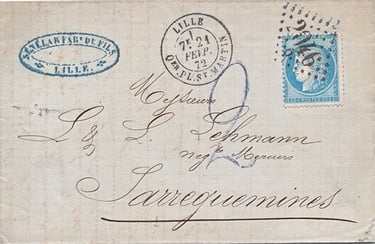
Letter dated 21 February 1872 from LILLE to SARREGUEMINES.
Tax "2" Groschen applied in METZ on 22 February.
When the French inland tariff was changed on 1 September 1871, the tax to be charged in the territories annexed by Germany remained unchanged. However, the tax on letters from these territories collected in France rose from 20 to 25 centimes.

